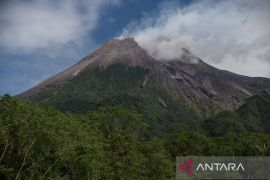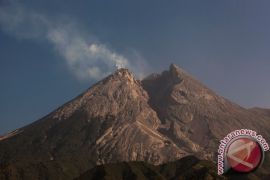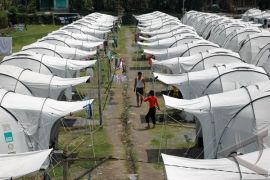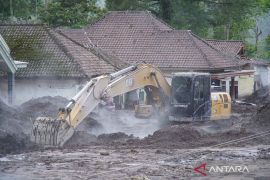Indeed, Merapi is closely linked to the spiritual life of many Javanese living nearby the volcano. And one of things the believe in is in essence a myth about the volcano`s periodic eruptions some of which took place on October 26-November, 2010 with catastrophic consequences for the local people.
"When Merapi was about to erupt, suddenly a character resembling the silhouette of wayang figure Petruk made of clouds appeared over the volcano," said Suswanto describing an unusual phenomenon that happened over the volcano a few hours prior to the first eruption on October 26, 2010.
In wayang stories, the Pandawa knights, especially Arjuna, are always accompanied by their loyal servants, the Punokawan consisting of Semar and his sons Gareng, Petruk and Bagong. Petruk is a tall man with a very long nose.
Suswanto said he captured the unique cloud formation in the shape of Petruk by camera by pure coincidence. However, after seeing the picture, he became convinced the cloud was of a quite unique shape, namely the shape of Petruk`s with his long nose.
The snapshots were taken by Suswanto on October 26, 2010 in the morning before Mt Merapi erupted. The distance between Merapi and his house was approximately 13 kilometers, a safe distance from the first stages of the disaster.
Suswanto and other residents had believed that the picture on the photo was "mbah (grandpa) Petruk, the "guardian" of Merapi. They soon spoke about the message the picture made of clouds conveyed, namely an ominous one.
Though not necessarily directly linked to the Petruk cloud formation over Merapi, the eventualities were catastrophic indeed after the three weeks of almost incessant eruptions. Some 350 people lost their lives engulfed by the wandering pyroclastic ashes that drifted down the slopes over a distance of at least 20 kms from the volcano`s crater.
Thousands of people are presently still living in shelters provided for by the government as their houses had been virtually wiped out by the flaming volcanic ashes and stones. At the peak of the disaster, the National Disaster Mitigation Agency (BNPB) said 500,000 people became displaced.
In material terms, some 7.1 billion rupiahs (approximately 670 million US dollars) were lost due to the disaster, according to the government.
Amidst the myth of Merapi, there had been a name, Mbah Marijan whom the Yogyakarta-sultanate had appointed guardian of the volcano, a traditional but mystical position to tame one of the world`s most active volcanoes.
The 83-year Maridjan had refused to leave his dwelling, just some 5 kms from the volcano`s summit. Along with some of his neighbors and family members, he was found dead, killed by the volcanic ashes that rained down on his village.
The gatekeeper was found dead in his house at Kinahrejo village, with his body in bowing position as if he was praying The tragic death of Mbah Marijan has proven that Merapi had meant it this time that nobody could stop it from showing its real might as a volcano.
At the time, speaking on behalf of the Yogyakarta Palace, Gusti Prabukusumo said the palace had a premonition about Mbah Maridjan`s fate. "We had known long before it happened that Mbah would be taken by Merapi," said Prabukusumo, the Sultan`s younger brother.
In 1970, Mbah Marijan was chosen as one of Yogyakarta Palace`s staff and given the royal title of Mas Penewu Suroksohargo. In 1982, he replaced his father as the guardian of the volcano and known for his dedication and loyalty to the Sultan.
In 2006, Mbah Marijan had refused to leave his village even though Merapi already spewed hot lava and ash cloud out of belief the volcano would not erupt. He was correct at the time, Merapi had cancelled its eruption, but the latest eruption signifying that the Mbah must be taken up as the eruption was unstoppable this time.
From an observation to the affected areas around Merapi earlier this month, the people mostly indicated that they had concerned more on their current miseries, something like a muffled anger over their fate due to the disaster. They seemed reluctant to talk much about the myth of Merapi.
"Just let it go, I don`t have much anymore to talk about the volcano. Yes, I still revere Merapi, but I still busy now with cleaning up this rumble from my house," said Parniwati (29) who was busily cleaning debris from a plot of land on which her house once stood at Pangukrejo, a hamlet at Umbulharjo village, Cangkringan district, Sleman.
Parniwati said she had wished that the disaster had not taken place at all considering the economic impacts brought down on her family by the disaster. "But, how could we do? The Almighty has destined upon us that Merapi had erupted like that," she said in a controlled choke of tears.
Interestingly, the course of events during the latest eruption, had brought to the consciousness of the Merapi residents the importance of logics and science as outlined by Dr. Surono, head of the Volcanology and Geological Disaster Management Agency, who like many Javanese carries only one name.
Surono had appeared from time to time during the three weeks of the disaster before television screens explaining people what will happen with the volcano minute by minute. Soon many people have called him the modern Merapi guardian.(*)
KR-VFT/HAJM/S012
Reporter: Vicki Febrianto
Editor: Jafar M Sidik
Copyright © ANTARA 2011





